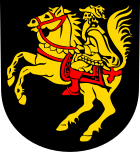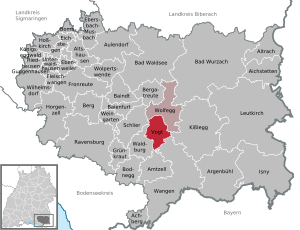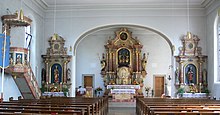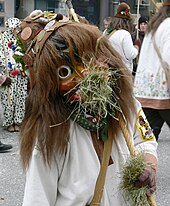Vogt (municipality)
| coat of arms | Germany map | |
|---|---|---|

|
Coordinates: 47 ° 47 ' N , 9 ° 46' E |
|
| Basic data | ||
| State : | Baden-Württemberg | |
| Administrative region : | Tübingen | |
| County : | Ravensburg | |
| Height : | 681 m above sea level NHN | |
| Area : | 22.31 km 2 | |
| Residents: | 4576 (December 31, 2018) | |
| Population density : | 205 inhabitants per km 2 | |
| Postal code : | 88267 | |
| Area code : | 07529 | |
| License plate : | RV, SLG , ÜB , WG | |
| Community key : | 08 4 36 078 | |
| Address of the municipal administration: |
Kirchstrasse 15 88267 Vogt |
|
| Website : | ||
| Mayor : | Peter Smigoc | |
| Location of the municipality Vogt in the district of Ravensburg | ||
Vogt is a municipality in the Upper Swabian district of Ravensburg in Baden-Württemberg ( Germany ).
The municipality, which extends over an area of 22.31 km², has about 4500 inhabitants.
geography
Geographical location
The municipality of Vogt is located between Wangen im Allgäu and Ravensburg directly on the south-eastern edge of the Altdorf Forest . With the name “ Tor zum Allgäu” , the municipality of Vogt advertises its location on the edge of the Allgäu countryside.
Neighboring communities
The following communities border the community of Vogt: Wolfegg in the north, Kißlegg in the east, the town of Wangen im Allgäu in the south-east, Waldburg in the south-west and Schlier in the west .
Protected areas
Three nature reserves ( Füremoos , Neuhauser Moos-Mollenweiher and Wolfegger Ach ) and a landscape protection area ( young moraine landscape between Amtzell and Vogt ) are designated in the municipality . (As of April 1, 2010)
history
The area of today's municipality was settled as early as the Neolithic . After the Romans and Alemanni, the Franks ruled the area from the end of the 5th century. They assigned these to the Argengau , which became the County of Altdorf , which was subordinate to the Welfs . Via the Staufer , the area fell to Austria , where it was counted to the Landvogtei Swabia . Smaller areas also belonged to the dominion of the Prince of Waldburg-Wolfegg-Waldsee . The media coverage due to the Reichsdeputationshauptschluss circuit led to the membership of the Kingdom of Württemberg , the territories in 1826 the new municipality Vogt merged.
Religions
Like the rest of the surrounding area, Vogt is Roman Catholic , but it also has a large, active Protestant community.
Roman Catholic
The parish is the seat of the parish of St. Anna. It belongs to the Allgäu-Oberschwaben dean's office formed in 2007. Although the Karsee community was part of Vogt until 1952, Vogt belonged to the Karsee parish until 1808 as a chaplain (branch parish) . The around 1500 on the district of the manor Stüber vorm Wald built (today, striking Allgäu pharmacy) chapel was in 1808 to the parish church consecrated. As a result of the Reichsdeputationshauptschluss of 1803, churches and monasteries were expropriated by the state as part of secularization . In 1833, the now much too small chapel was demolished and today's parish church of St. Anna was built in the finance chamber style (financed by the then Kingdom of Württemberg ) over a four-year construction period. It was fundamentally modernized in 1977/78 during the term of office of Pastor Maximilian Hess. Contrary to the trend of the Second Vatican Council towards comprehensive modernization at the time, the high altar was largely left in place at the behest of the monument authority and essentially only moved back against the wall. The space thus gained in the choir was used for an additional altar table , a modern folk altar. This altar table is following the modern liturgical rule towards the main nave of the church, thus facing the parish and based on the style of the existing altars. The pulpit was left in Vogt, unlike in many churches in which - following the zeitgeist of the time - the pulpits were dismantled, as were the two side altars, but it is no longer in use for liturgical reasons. The liturgical reform and the installation of modern public address systems made the elevated position of the pulpit no longer necessary. Several key objectives of this reform were implemented: The language was changed from Latin to German and the pastor now arranged the service to face the congregation at eye level. In retrospect, the modernization of that time is generally described in the community as a “very successful compromise” between the existing structure and the requirement of the modern liturgical order.
The relocation of the traffic-technically unfavorable side entrance from Kirchstrasse to the north-west side with a new, spacious entrance area, modernization of the heating system, conversion of the bell to radio clock , a new sacristy extension , organ and choir design also took place. The design of the north courtyard of the church, a structural opening of the soldier memorial at the eastern end of the church (an additional, second war memorial was created on the new forest cemetery in the mid-1980s), traffic calming of the church road and modernization and conversion of the historic rectory built in 1777 were all Part of a complete modernization of the village in coordination with the Vogt municipal administration.
Evangelical
The Protestant parish of Vogt, founded in 1899, was a branch parish of the Atzenweiler parish for a long time and has been independent since 2003. The diaspora community belongs to the deanery in Ravensburg and has 860 community members (as of 2005).
politics
Municipal council
The municipal council is composed of the mayor, who chairs it, and 14 volunteer citizens elected in the local elections on May 26, 2019. The voter turnout for the 3701 eligible voters was 64%. The seats were distributed as follows:
| Party / list | Seats | % |
| Independent citizens | 8 (−1) | 57.6% |
| CDU | 6 (+1) | 42.4% |
mayor
Gernold Wassmer was mayor of Vogt until 2002. Eight applicants applied for the successor, remarkable because not a few municipalities lack suitable applicants. Peter Smigoc was then elected in the second ballot for his first eight-year term. In October 2010 he was confirmed with 98.2% of the valid votes for another eight years. The turnout was 38.4%; Opposing candidates could not be set up.
coat of arms
Blazon: In a black field a soaring golden horse with a red bridle, on which a bearded man in a yellow robe, a yellow hat with a plume and red gauntlets sits.
Parish partnership
Vogt has had a partnership with Le Mayet-de-Montagne in Auvergne in France since 1992 .
Economy and Infrastructure
traffic
The municipality of Vogt is by some bus lines u. a. connected with Ravensburg , Wangen im Allgäu and Wolfegg and belongs to the Bodensee-Oberschwaben Verkehrsverbund ( bodo ).
Public facilities
police
During an administrative reform of the country, the police stations Waldburg, Wolfegg and Kisslegg were brought together in Vogt. The newly created Vogt police station is responsible for seven communities with around 30,000 inhabitants.
education
Vogt has three kindergartens and a forest kindergarten, a primary school and a branch of the Waldburg-Vogt community school . The Volkshochschule Vogt ( VHS ) has its organizational headquarters in the town hall, is part of the VHS Ravensburg eV as a “branch office Vogt” and uses the rooms of the public schools in Vogt.
Culture and sights
Buildings
The manor Mosisgreut is a hunting lodge with a medieval predecessor building from the 16th century and is located in a landscape protection area. A true to original restoration took place between 2005 and 2008. The hunting lodge is surrounded by a historical building ensemble: inner courtyard with neo-Gothic east wing, former brick and cheese factory building, two-storey farm building made of granite blocks, moat with natural stone bridge and a Gothic chapel. Its original furnishings include an altar that Theodor Schnell the Elder created. In 2012, the owners were awarded the Baden-Württemberg Monument Protection Prize for the renovation of the main building in accordance with the requirements of the listed building .
Regular events
- The Swabian-Alemannic carnival is celebrated in Vogt . The driving force is the fool's guild “Vogter Heufresser”.
Personalities
- Fritz B. Busch (1922–2010), journalist and founder of the automobile museum in Wolfegg, lived and died in Vogt
- Britta Horn (* 1980), actress, grew up in Vogt
literature
- Vogt. The gateway to the Allgäu. Pictures from the old days . Geiger, Horb am Neckar 1984
- Svenja Hecklau, Vogt parish, Catholic parish, Ev. Parish (ed.): Heimatbuch Vogt. History and stories. Municipality, Vogt 2008, ISBN 978-3-00-025080-4 (extensive book on history, settlement, agriculture and industry, church, school, social and club affairs)
Web links
Individual evidence
- ↑ State Statistical Office Baden-Württemberg - Population by nationality and gender on December 31, 2018 (CSV file) ( help on this ).
- ↑ a b c d e f Little Church Leader - St. Anna Vogt, Gregor Maier, 1995
- ↑ Election results of the municipal council 2019 current. Retrieved June 3, 2019 .
- ↑ Official website of the VHS Ravensburg







